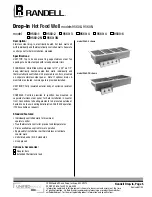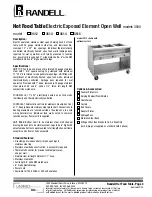
10.) Stir the food before feeding the baby in order to spread the temperature
evenly.
Note 1: Always test the food temperature before feeding so as not to hurt the
baby.
Note 2: Wait for about a minute before taking out the jar from the warmer, to
let it cool down and to avoid burning your hands.
C. Sterilizing small feeding accessories (high temperature ~ 100
°
C) (Fig. S1-2):
Note: Working under high temperature will lead to easier damaging of the unit. In
order to prolong its life, do not use this function too often!
1.) Fill the warmer with 30 ml water.
2.) Put small articles such as pacifiers or teats into the warmer.
3.) Plug the supply cord into an electrical power outlet and turn the knob into the
following setting:
4.) The LED indicator will flash in red.
5.) The sterilization will end after several minutes and the LED indicator will turn
off.
6.) Place the button in position OFF and unplug the supply cord to turn the device
off.
7.) Leave the appliance to cool down completely before taking out the sterilized
object.
8.) Pour out the remaining water from the appliance and wipe it dry.
18
GUIDELINES FOR MAINTANCE AND CLEANING OF THE BOTTLE WARMER
A. CLEANING:
1. Before cleaning the product, turn off the power switch, unplug the supply cord
from the power outlet and leave the appliance to cool down.
2. Take out the bowl and wipe inside and outside the product only with damp
cloth and soft cleanser.
3. Do not use strong detergents for cleaning the product – bleach, alcohol – based
ones and such with abrasive parts.
4. We recommend you to use pre-boiled or filtered water in order to reduce the
risk of lime scale deposition.
B. DESCALING:
1. You should descale the Electric and Baby Food Warmer every four weeks to
ensure that the unit will continue working 100% effectively.
2. OR: Mix one sachet of citric acid (10g) with 200 ml/7 oz water. Pour the solution
in the warmer. Plug the electric cable in the unit and in the power outlet, then
turn the knob into the third setting and heat for 10 minutes. After 10 minutes turn
Summary of Contents for BABYDUO
Page 2: ...PARTS AND FUNCTIONS KOMPONENTEN UND FUNKTIONEN COMPONENTE I FUNC II COMPONENTEN EN FUNCTIES 1...
Page 3: ...1 2 3 4 5 6 BG 2 2...
Page 4: ...7 8 9 10 220 240 V 50 HZ 150 W 11 12 13 14 15 16 17 18 19 20 21 3...
Page 5: ...22 23 CANGAROO 24 25 4...
Page 6: ...1 220 240V 2 50Hz 3 150W 26 27 28 EN60335 EN55014 EN61000 PD B C D E F 5 20 C 5 C...
Page 7: ...OFF 40 C 70 C 100 C 6 BW1 5 1 100 120 ml 2 3 4 120ml...
Page 8: ...5 6 LED 7 LED 8 LED 9 OFF 10 11 12 FW1 3 1 100ml 2 3 4 5 LED 6 LED 7 LED LED 8 9 10 7...
Page 9: ...1 2 100 C S1 2 1 30ml 2 3 4 LED 5 LED 6 OFF 7 8 1 2 3 4 1 1 100 2 10g 200 ml 7 oz 3 10 8...
Page 11: ...114 1 113 1 2 2 3 61 2014 25 07 2014 115 4 3 61 2014 25 07 2014 115 1 2 1 3 1 1 10...
Page 12: ...1 2 11...
Page 13: ...119 CANGAROO 1 02 936 07 90 12...
Page 28: ...1 2 3 4 5 6 GR 27...
Page 29: ...7 8 9 10 220 240 V 50 HZ 150 W 11 12 13 14 15 16 17 18 19 20 21 22 28...
Page 30: ...23 CANGAROO 24 25 29...
Page 31: ...1 220 240V 2 50 Hz 3 150W PD B C D E F 26 27 28 EN60335 EN55014 EN61000 30...
Page 32: ...20 C 5 C OFF 40 C 70 C 100 C 31...
Page 34: ...1 2 3 8 9 10 1 2 C 100 C S1 2 1 30ml 2 3 4 LED 5 LED 6 OFF 7 8 33...
Page 35: ...34 4 1 2 10 200 ml 7 oz 3 10 10 30 3 50ml 2oz 100ml 4oz CANGAROO 1 359 2 936 07 90...







































